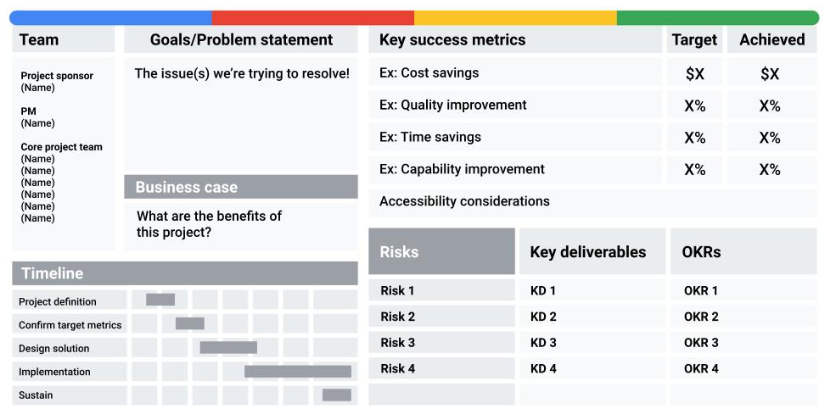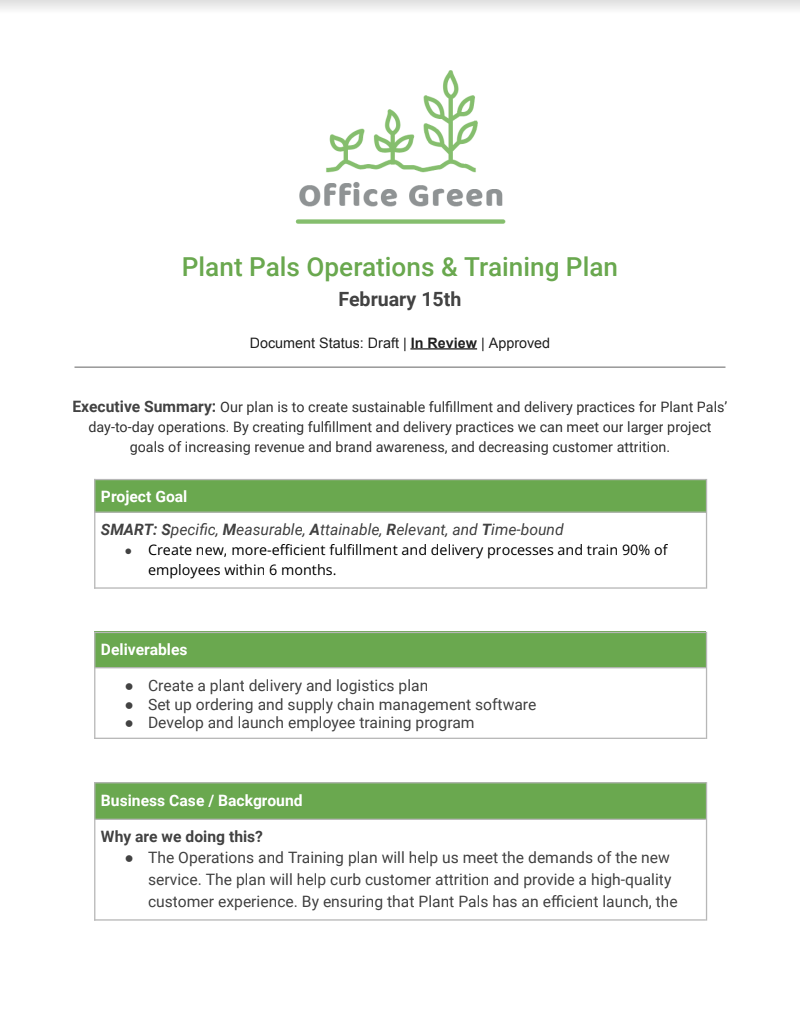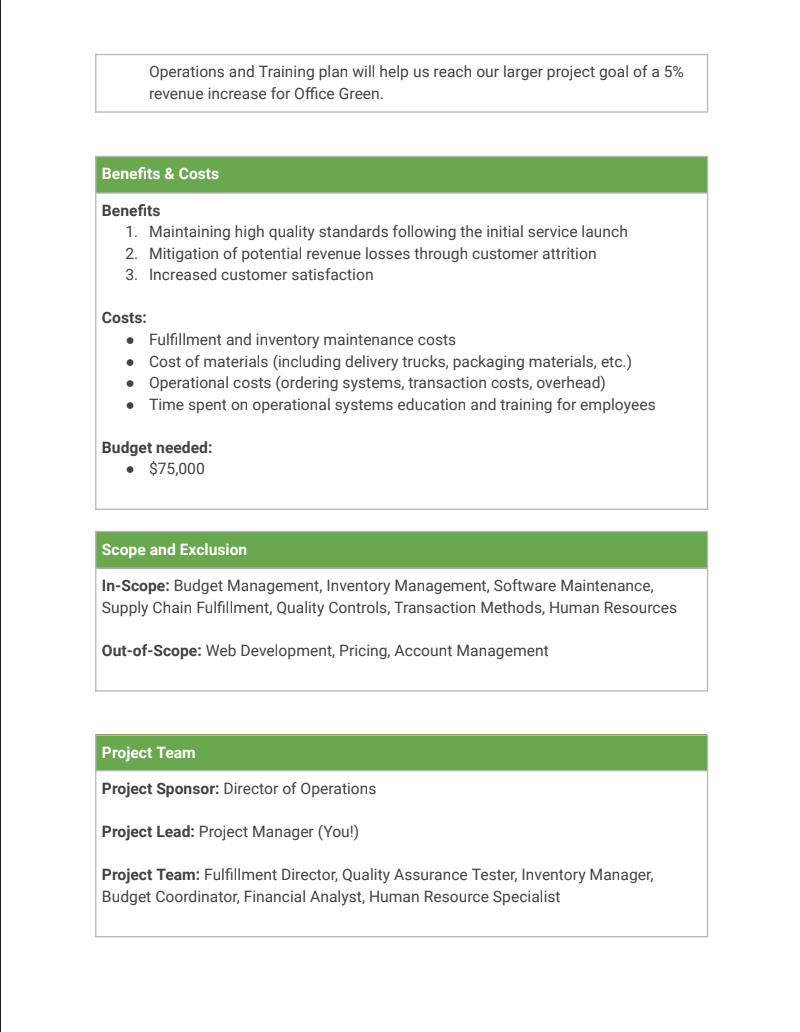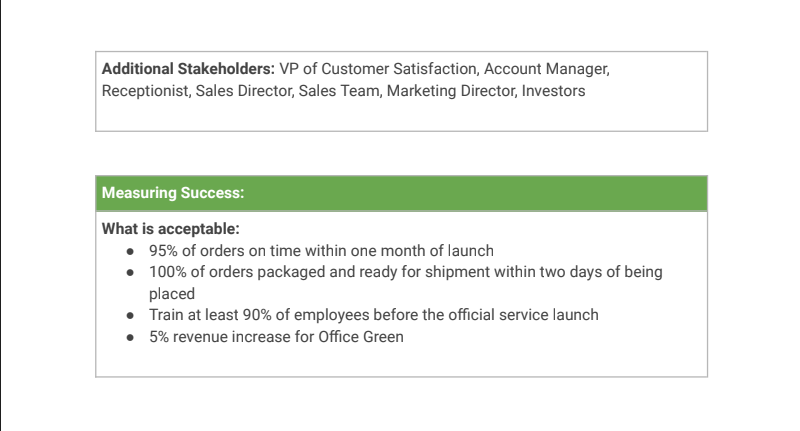Utilize Resources and Tools
Understanding Project Resource Needs
Essential project resources
Project resources usually include
Budget: An estimate of the amount of money a project will cost to complete
- Ask question to help uncover hidden cost, e.g.,
- Are there any taxes on products that you need to account for?
- What about extra fees?
- Common aspects of your project budget will include:
- Team: the cost of the people performing the work
- Services: any outside vendors helping your project
- Materials: any tangible items purchased to complete the project
- You’ll often include the budget in the project charter, and the stakeholders review it for approval.
People: Who help execute the tasks of a project, i.e., a team of people with a variety of skill sets and specialties to get the job done
Materials: Items you need to help get the project done
It’s important to figure out your resources before the project gets rolling. This makes it easy for everyone on your team to get their work done.
Tools: Aids that make it easier for a project manager or team to manage resources and organize work.
- Track tasks
- Manage budgets
- Collaborate with teammates
Developing Documentation for Project Kick-off
It is the project manager’s job to keep track of every new decision and use those decisions to create a plan. That includes everything from identifying project goals and deliverables to choosing the right people to add to a team.
Clear and consistent documentation
- Can ensure transparency and clear communication
- Helps set the stage for the project
- Communicates the answers to key questions
- what problem are you trying to solve?
- What are the project goals?
- What are the scope and deliverables, and who are the project’s stakeholders?
- What resources does the team need to complete their work?
- Helps preserve decisions made early on in the project and can serve as a reference point for team members who might join later in the project life cycle
Project proposals and charters 101
Project proposal: A form of documentation that persuades a stakeholder to begin a project
- A great starting point to help you understand the desired goals and impact
- Could be a formal document, a presentation, or even a simple email to get others on board with the idea
Project charter: A formal document that clearly defines the project and outlines the necessary details to reach its goals
Helps you get organized
Set up a framework for what needs to be done
Communicate those details to others, ensures that you and your stakeholders agree on the project value.
Makes clear that the benefits of the project outweigh the costs
- What value will this project create?
- How much money could this project save my organization?
- How much time will people have to spend on this project?
You’ll include the answers to these questions in your charter, which ensures that you and your stakeholders agree on the project value.
A best practice for ensuring that everyone agrees on how to move forward before entering the planning phase.
Is a living document and can evolve as the project progresses
Difference between project proposal and project charter
A project proposal is created earlier in the project life cycle than the project charter, which kicks off the initiation phase by influencing and persuading the company to move forward with the project. The project charter serves a similar purpose and often comes at the end of the initiation phase. However, its goal is to more clearly define the key details of the project.
A charter will often serve as a point of reference throughout the life of a project, while the proposal is only used at the earlier stages.
Project charters: Elements and formats
A project charter clearly defines the project and outlines the necessary details for the project to reach its goals.
Capture the project’s goals, values, benefits, and details
Developing the project charter in collaboration with your team and stakeholders can help you make sure that your project charter addresses your key stakeholders’ most important concerns and keeps your team aligned.
Project charters can vary from organization to organization and from project to project. -> It is key for a project manager to identify the best type of charter for the project in order to capture the relevant information and set your project up for success.
Usually include some combination of the following key information:
- introduction/project summary
- goals/objectives
- business case/benefits and costs
- project team
- scope
- success criteria
- major requirements or key deliverables
- budget
- schedule/timeline or milestones
- constraints and assumptions
- risks
- OKRs
- approvals
Example

Developing a project charter
- At the top of your charter, you’ll want to add in the name of your project.
- Add a brief summary
- Fill in the “project goals” section (goals should be SMART)
- Add in the project deliverable (tangible outcome from a project)
- Add in the business case, which captures the reasoning for initiating this project and is supported by the cost benefit analysis
- Add in project scope (in-scope and out-of-scope)
- Add in project team
- Add in additional stakeholders
- Add in how we’ll measure success
Example



Evaluating Tools to Meet Project Needs
Project management tools help you
- Track task deadlines
- Provide visibility to others
- Manage a budget
- Create helpful diagrams
- Manage contracts
Introducing new tools to a team
Before you introduce a new tool to your team, you should be sure that this change is actually going to benefit the project, and ensure that those involved in your project understand the benefits of this change. Demonstrating to your teammates and stakeholders that you understand the tool and have evaluated its competency will help build trust, especially if this new tool is replacing an existing tool.
Important considerations and keys to successfully introducing new tools:
Discuss the tool early and often, if possible.
The team should not feel blindsided by a new change. Make sure they know the change is coming as early as possible. -> This will help them prepare for an introduction or migration to the new tool.
Ask for feedback from key stakeholders.
- You could get great feedback on features that you may have overlooked by asking for their expertise.
- You can solicit this feedback by requesting their input about functionality or have them list features in order of priority.
- The key is to create an opportunity for stakeholders to provide their feedback and allow you to incorporate their feedback into next steps.
Involve the key stakeholders in demonstrations as you get closer to making the final decision on the project tracking tool.
- You will be able to leverage key stakeholders’ acceptance by letting them test the product or sign up for a trial run.
- You will be able to leverage key stakeholders’ acceptance by letting them test the product or sign up for a trial run.
- You may want to pull in key users from your team to test and familiarize themselves with the tool prior to rolling it out.
- This will allow the team to get on board with your plans or discuss their concerns beforehand.
- This will also highlight in-house experts for future training, assistance, and implementation.
Ensure the tool is fully functional before the team is introduced to it.
Set up training for the tool as needed before you ask the team to actually use it.
- It is your job as the project manager to ensure that each team members’ needs are addressed.
- Setting up training also helps create positive first impressions, which will lead to higher productivity and quicker, more successful implementation and acceptance.
Remember, some pushback is normal, but successful project managers should take the steps to prepare and mitigate any friction for their team when possible.
Tip
- If time allows, plan for a period of transition if you are replacing an existing tool.
- It is common to allow both tools to operate during this period.
- Be prepared for productivity to be impacted as the team transitions from one tool to another.
Exploring types of project management tools
Scheduling and work management software
- Really useful for assigning tasks to multiple teammates and for tracking progress on that work
- Help you visualize your team’s progress
- Provide an overview of how the project is going
Productivity tools
- Online share documents (e.g., MS Word or Google Docs)
- Meeting agendas
- Status updates
- Spreadsheets
- RACI chars
- Project plans
- Presentations
- Project overviews
Collaboration tools
- Email and chats
Demonstrating your knowledge of project management tools
During an interview for a project manager position, the interviewer may ask you to discuss the project management tools you are familiar with or have used in the past. Being able to talk about these tools, and how you use them, will be crucial to landing the role.
In addition to the interviewer asking general questions about tools, they may ask more specific questions
- “How do you know if a project is off track?” It’s important to tie this answer back to the types of scheduling tools you have learned about. If you haven’t had experience working with certain scheduling tools, like Smartsheet or digital spreadsheets—try to leverage real-life experience.
- “How do you execute tasks within your timeline?” This is a great opportunity to demonstrate your ability to be productive by sharing your experience with tools, such as digital documents or spreadsheets. These tools help you create project artifacts, track tasks, and store project details in one place! You can also use them as a collaboration tool because they are easily shareable with teammates and stakeholders and allow for real-time updates.